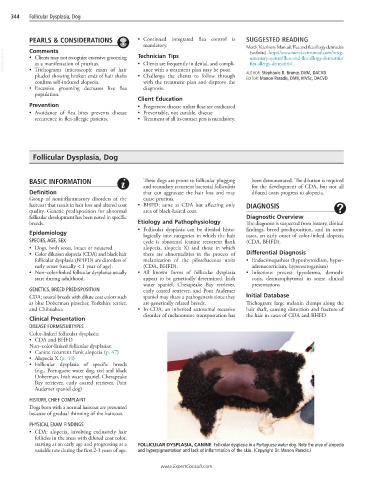Page 734 - Cote clinical veterinary advisor dogs and cats 4th
P. 734
344 Follicular Dysplasia, Dog
PEARLS & CONSIDERATIONS • Continued integrated flea control is SUGGESTED READING
mandatory. Merck Veterinary Manual: Flea and flea allergy dermatitis
Comments
VetBooks.ir • Clients may not recognize excessive grooming Technician Tips (website). http://www.merckvetmanual.com/integ-
umentary-system/fleas-and-flea-allergy-dermatitis/
as a manifestation of pruritus.
• Clients are frequently in denial, and compli-
flea-allergy-dermatitis/.
• Trichograms (microscopic exam of hair
ance with a treatment plan may be poor.
plucks) showing broken ends of hair shafts • Challenge the clients to follow through AUTHOR: Stephanie R. Bruner, DVM, DACVD
EDITOR: Manon Paradis, DMV, MVSc, DACVD
confirm self-induced alopecia. with the treatment plan and disprove the
• Excessive grooming decreases live flea diagnosis.
population.
Client Education
Prevention • Progressive disease unless fleas are eradicated
• Avoidance of flea bites prevents disease • Preventable, not curable, disease
recurrence in flea-allergic patients. • Treatment of all in-contact pets is mandatory.
Follicular Dysplasia, Dog
BASIC INFORMATION These dogs are prone to follicular plugging been demonstrated. The dilution is required
and secondary recurrent bacterial folliculitis for the development of CDA, but not all
Definition that can aggravate the hair loss and may diluted coats progress to alopecia.
Group of noninflammatory disorders of the cause pruritus.
haircoat that result in hair loss and altered coat • BHFD: same as CDA but affecting only DIAGNOSIS
quality. Genetic predisposition for abnormal area of black-haired coat.
follicular development has been noted in specific Diagnostic Overview
breeds. Etiology and Pathophysiology The diagnosis is suspected from history, clinical
• Follicular dysplasia can be divided histo- findings, breed predisposition, and in some
Epidemiology logically into categories in which the hair cases, an early onset of color-linked alopecia
SPECIES, AGE, SEX cycle is abnormal (canine recurrent flank (CDA, BHFD).
• Dogs, both sexes, intact or neutered alopecia, alopecia X) and those in which
• Color dilution alopecia (CDA) and black hair there are abnormalities in the process of Differential Diagnosis
follicular dysplasia (BHFD) are disorders of melanization of the pilosebaceous units • Endocrinopathies (hypothyroidism, hyper-
early onset (usually < 1 year of age). (CDA, BHFD). adrenocorticism, hyperestrogenism)
• Non–color-linked follicular dysplasias usually • All known forms of follicular dysplasia • Infectious process (pyoderma, demodi-
start during adulthood. appear to be genetically determined. Irish cosis, dermatophytosis) in some clinical
water spaniel, Chesapeake Bay retriever, presentations
GENETICS, BREED PREDISPOSITION curly coated retriever, and Pont Audemer
CDA: several breeds with dilute coat colors such spaniel may share a pathogenesis since they Initial Database
as blue Doberman pinscher, Yorkshire terrier, are genetically related breeds. Trichogram: large melanin clumps along the
and Chihuahua • In CDA, an inherited autosomal recessive hair shaft, causing distortion and fracture of
disorder of melanosome transportation has the hair in cases of CDA and BHFD
Clinical Presentation
DISEASE FORMS/SUBTYPES
Color-linked follicular dysplasia:
• CDA and BHFD
Non–color-linked follicular dysplasias:
• Canine recurrent flank alopecia (p. 47)
• Alopecia X (p. 44)
• Follicular dysplasia of specific breeds
(e.g., Portuguese water dog, red and black
Doberman, Irish water spaniel, Chesapeake
Bay retriever, curly coated retriever, Pont
Audemer spaniel dog)
HISTORY, CHIEF COMPLAINT
Dogs born with a normal haircoat are presented
because of gradual thinning of the haircoat.
PHYSICAL EXAM FINDINGS
• CDA: alopecia, involving exclusively hair
follicles in the areas with diluted coat color,
starting at an early age and progressing at a FOLLICULAR DYSPLASIA, CANINE Follicular dysplasia in a Portuguese water dog. Note the area of alopecia
variable rate during the first 2-3 years of age. and hyperpigmentation and lack of inflammation of the skin. (Copyright Dr. Manon Paradis.)
www.ExpertConsult.com

